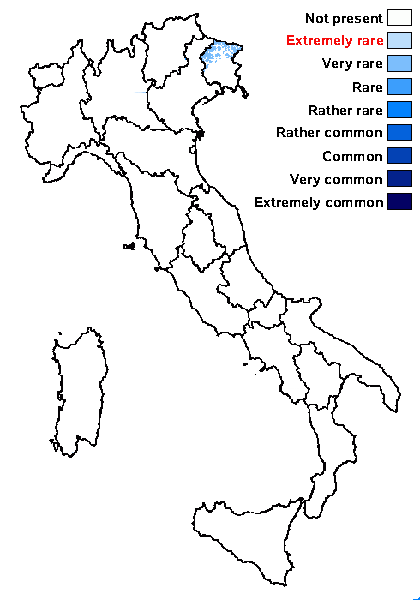Phacographa protoparmeliae Hafellner
Bibl. Lichenol., 100: 106, 2009.
Synonyms:
Distribution: N - Frl (Hafellner 2009, Brackel 2016).
Description: Thallus not evident, not lichenized, parasitic on the thalli of Protoparmelia badia. Apothecia arranged in dense groups of mostly 3-10 or dispersed; individual apothecia semi-immersed only at the beginning, later more or less sessile, with a widely exposed, rough, dark brown disc, and an often delicately fissured, black margin. Exciple 40-60 μm wide, dark brown, basally fusing with a 70-100 μm high, dark brown hypothecium; epithecium medium brown, granular, K-; hymenium colourless, 70-80 μm high including the epithecium, the hymenial gel hemiamyloid; paraphysoids branched and anastomosing, 2-3 μm thick in lower part, the apical cells 4-6 μm wide; subhymenium 20-40 μm high. Asci (4-)8-spored, broadly cylindrical to subclavate, the wall I- and K/I- except for an apical ring that is K/I+ blue. Ascospores 3-septate, hyaline, 18-21(-23) x 6-7 μm, with a distinct perispore, the old ones with a brownish verruculose sculpture. Photobiont absent. Spot tests: all negative. Chemistry: no lichen substances.Note: a lichenicolous fungus on saxicolous species of Protoparmelia, especially P. badia. The record from Friuli of Opegrapha glaucomaria by Tretiach & Hafellner (2000) refers to this species (Hafellner 2009).
Growth form: Lichenicolous fungus
Substrata: rocks
Reproductive strategy: mainly sexual
paras Protoparmelia spp.
Commonnes-rarity: (info)
Alpine belt: very rare
Subalpine belt: very rare
Oromediterranean belt: absent
Montane belt: very rare
Submediterranean belt: absent
Padanian area: absent
Humid submediterranean belt: absent
Humid mediterranean belt: absent
Dry mediterranean belt: absent

Predictive model
Growth form: Lichenicolous fungus
Substrata: rocks
Reproductive strategy: mainly sexual
paras Protoparmelia spp.
Commonnes-rarity: (info)
Alpine belt: very rare
Subalpine belt: very rare
Oromediterranean belt: absent
Montane belt: very rare
Submediterranean belt: absent
Padanian area: absent
Humid submediterranean belt: absent
Humid mediterranean belt: absent
Dry mediterranean belt: absent

Predictive model
 Index Fungorum
Index Fungorum
 GBIF
GBIF

